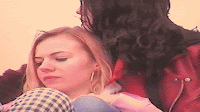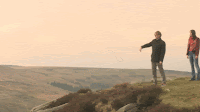I think the
finished film Scarlet Heath is a
success, and I’m happy with how it turned out. We took a chance with how we
told the story, such as shooting on tape, zooming out from the tape (which told
a great deal of the story) and using little dialogue. Although this makes the
story much harder to follow, I like how subtle it is. It isn’t necessary to
know the characters names and backstory, but instead see the situation they are
in.
Writing the
script was hard as we had some parts pure cinema (without dialogue) and others with
heavy dialogue, which was hard to make sound serious as it was an argument. We
decided to write as close to realistic as we could, and improvise slightly off
of what we had written on the day.
A difficulty of shooting was shooting on tape. The camera was at least 15 years old and had to be tested if it worked. I had to learn how to use it days before shooting and buy backup tapes. Because in Josh plays the tape direct from the camera in the first scene, we had to shoot all of the tape scenes back to back in chronological order as we planned not to edit it. If it didn’t work we planned to edit it and make it look like it was playing off the camera, but thankfully everything went to plan, allowing us to film using the footage the next day on the screen.
A difficulty of shooting was shooting on tape. The camera was at least 15 years old and had to be tested if it worked. I had to learn how to use it days before shooting and buy backup tapes. Because in Josh plays the tape direct from the camera in the first scene, we had to shoot all of the tape scenes back to back in chronological order as we planned not to edit it. If it didn’t work we planned to edit it and make it look like it was playing off the camera, but thankfully everything went to plan, allowing us to film using the footage the next day on the screen.
Another
issue with shooting on a diegetic tape camera was it could turn the film into a
found footage/POV film and not be taken seriously. However, this is fixed with
the smooth zoom out which contrasts the handheld aesthetic. Although the second
half has different cinematography to the tape, appearing more realistic through
static camerawork, we used slight jumps in the edit to suggest that this scene
also lacked realism, and could perhaps also be a film. The scene’s lack of
realism is communicated also by the ghostly disappearance and reappearance of
Madison and Alice.


Shooting
only lasted two days back to back, giving plenty of time to the edit. The first
day was the most difficult to organise, as it meant transporting the equipment
and actors to fox house on the peak district, which involved buses and taxis.
We chose this location as it was near a pub and on a popular bus route,
allowing us easy shelter, catering and transport. However, a short walk away
and we had the wilderness we needed for our film.
We took inspiration from multiple films visually and thematically, such as Gaspar Noé’s Irreversible and Love, Michael Haneke’s Caché and Code Unknown, Wong Kar Wai’s 2046 and Andrei Tarkovsky’s Mirror. We decided to use ideas such as the camera pulling out from a screen from Code Unknown and Love. The letting go of the tape was inspired by the freeing of the bird in Mirror, signalling death and freedom. Josh being haunted by previous lovers was inspired by 2046, a film containing being haunted by a previous lover.

Code Unknown (Haneke, 2000)
and Love (Noé, 2015)
Mirror (Tarkovsky, 1975)





No comments:
Post a Comment